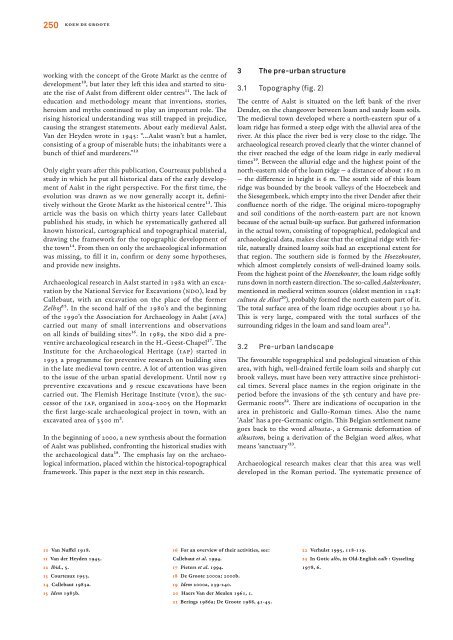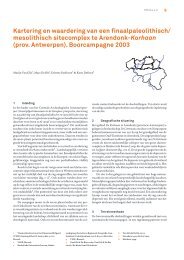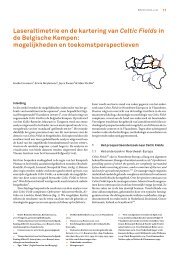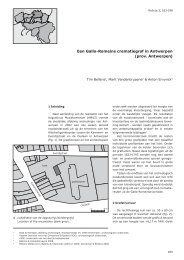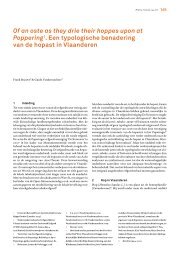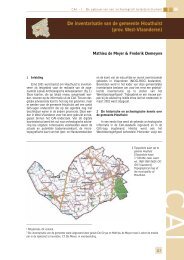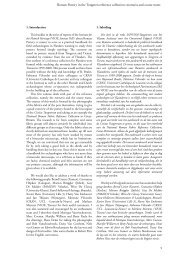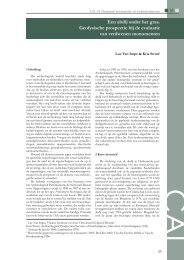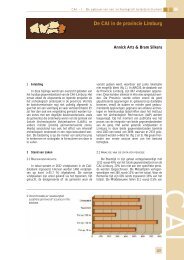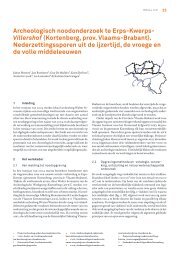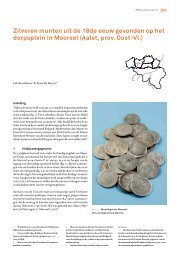Exchanging Medieval Material Culture Studies on archaeology and ...
Exchanging Medieval Material Culture Studies on archaeology and ...
Exchanging Medieval Material Culture Studies on archaeology and ...
Create successful ePaper yourself
Turn your PDF publications into a flip-book with our unique Google optimized e-Paper software.
250<br />
Koen De Groote<br />
working with the c<strong>on</strong>cept of the Grote Markt as the centre of<br />
development10, but later they left this idea <strong>and</strong> started to situate<br />
the rise of Aalst from diff erent older centres11. Th e lack of<br />
educati<strong>on</strong> <strong>and</strong> methodology meant that inventi<strong>on</strong>s, stories,<br />
heroism <strong>and</strong> myths c<strong>on</strong>tinued to play an important role. Th e<br />
rising historical underst<strong>and</strong>ing was still trapped in prejudice,<br />
causing the strangest statements. About early medieval Aalst,<br />
Van der Heyden wrote in 1945: “…Aalst wasn’t but a hamlet,<br />
c<strong>on</strong>sisting of a group of miserable huts; the inhabitants were a<br />
bunch of thief <strong>and</strong> murderers.”12<br />
Only eight years aft er this publicati<strong>on</strong>, Courteaux published a<br />
study in which he put all historical data of the early development<br />
of Aalst in the right perspective. For the fi rst time, the<br />
evoluti<strong>on</strong> was drawn as we now generally accept it, defi nitively<br />
without the Grote Markt as the historical centre13. Th is<br />
article was the basis <strong>on</strong> which thirty years later Callebaut<br />
published his study, in which he systematically gathered all<br />
known historical, cartographical <strong>and</strong> topographical material,<br />
drawing the framework for the topographic development of<br />
the town14. From then <strong>on</strong> <strong>on</strong>ly the archaeological informati<strong>on</strong><br />
was missing, to fi ll it in, c<strong>on</strong>fi rm or deny some hypotheses,<br />
<strong>and</strong> provide new insights.<br />
Archaeological research in Aalst started in 1982 with an excavati<strong>on</strong><br />
by the Nati<strong>on</strong>al Service for Excavati<strong>on</strong>s (ndo), lead by<br />
Callebaut, with an excavati<strong>on</strong> <strong>on</strong> the place of the former<br />
Zelhof15. In the sec<strong>on</strong>d half of the 1980’s <strong>and</strong> the beginning<br />
of the 1990’s the Associati<strong>on</strong> for Archaeology in Aalst (ava)<br />
carried out many of small interventi<strong>on</strong>s <strong>and</strong> observati<strong>on</strong>s<br />
<strong>on</strong> all kinds of building sites16. In 1989, the ndo did a preventive<br />
archaeological research in the H.-Geest-Chapel17. Th e<br />
Institute for the Archaeological Heritage (iap) started in<br />
1993 a programme for preventive research <strong>on</strong> building sites<br />
in the late medieval town centre. A lot of attenti<strong>on</strong> was given<br />
to the issue of the urban spatial development. Until now 19<br />
preventive excavati<strong>on</strong>s <strong>and</strong> 9 rescue excavati<strong>on</strong>s have been<br />
carried out. Th e Flemish Heritage Institute (vioe), the successor<br />
of the iap, organised in 2004-2005 <strong>on</strong> the Hopmarkt<br />
the fi rst large-scale archaeological project in town, with an<br />
excavated area of 3500 m².<br />
In the beginning of 2000, a new synthesis about the formati<strong>on</strong><br />
of Aalst was published, c<strong>on</strong>fr<strong>on</strong>ting the historical studies with<br />
the archaeological data18. Th e emphasis lay <strong>on</strong> the archaeological<br />
informati<strong>on</strong>, placed within the historical-topographical<br />
framework. Th is paper is the next step in this research.<br />
10 Van Nuff el 1918.<br />
11 Van der Heyden 1945.<br />
12 Ibid., 5.<br />
13 Courteaux 1953.<br />
14 Callebaut 1983a.<br />
15 Idem 1983b.<br />
16 For an overview of their activities, see:<br />
Callebaut et al. 1994.<br />
17 Pieters et al. 1994.<br />
18 De Groote 2000a; 2000b.<br />
19 Idem 2000a, 239-240.<br />
20 Haers Van der Meulen 1961, 1.<br />
21 Berings 1986a; De Groote 1988, 41-45.<br />
3 The pre-urban structure<br />
3.1 Topography (fig. 2)<br />
Th e centre of Aalst is situated <strong>on</strong> the left bank of the river<br />
Dender, <strong>on</strong> the changeover between loam <strong>and</strong> s<strong>and</strong>y loam soils.<br />
Th e medieval town developed where a north-eastern spur of a<br />
loam ridge has formed a steep edge with the alluvial area of the<br />
river. At this place the river bed is very close to the ridge. Th e<br />
archaeological research proved clearly that the winter channel of<br />
the river reached the edge of the loam ridge in early medieval<br />
times19. Between the alluvial edge <strong>and</strong> the highest point of the<br />
north-eastern side of the loam ridge − a distance of about 180 m<br />
− the diff erence in height is 6 m. Th e south side of this loam<br />
ridge was bounded by the brook valleys of the Hoezebeek <strong>and</strong><br />
the Siesegembeek, which empty into the river Dender aft er their<br />
c<strong>on</strong>fl uence north of the ridge. Th e original micro-topography<br />
<strong>and</strong> soil c<strong>on</strong>diti<strong>on</strong>s of the north-eastern part are not known<br />
because of the actual built-up surface. But gathered informati<strong>on</strong><br />
in the actual town, c<strong>on</strong>sisting of topographical, pedological <strong>and</strong><br />
archaeological data, makes clear that the original ridge with fertile,<br />
naturally drained loamy soils had an excepti<strong>on</strong>al extent for<br />
that regi<strong>on</strong>. Th e southern side is formed by the Hoezekouter,<br />
which almost completely c<strong>on</strong>sists of well-drained loamy soils.<br />
From the highest point of the Hoezekouter, the loam ridge soft ly<br />
runs down in north eastern directi<strong>on</strong>. Th e so-called Aalsterkouter,<br />
menti<strong>on</strong>ed in medieval written sources (oldest menti<strong>on</strong> in 1248:<br />
cultura de Alost20), probably formed the north eastern part of it.<br />
Th e total surface area of the loam ridge occupies about 130 ha.<br />
Th is is very large, compared with the total surfaces of the<br />
surrounding ridges in the loam <strong>and</strong> s<strong>and</strong> loam area21.<br />
3.2 Pre-urban l<strong>and</strong>scape<br />
Th e favourable topographical <strong>and</strong> pedological situati<strong>on</strong> of this<br />
area, with high, well-drained fertile loam soils <strong>and</strong> sharply cut<br />
brook valleys, must have been very attractive since prehistorical<br />
times. Several place names in the regi<strong>on</strong> originate in the<br />
period before the invasi<strong>on</strong>s of the 5th century <strong>and</strong> have pre-<br />
Germanic roots22. Th ere are indicati<strong>on</strong>s of occupati<strong>on</strong> in the<br />
area in prehistoric <strong>and</strong> Gallo-Roman times. Also the name<br />
‘Aalst’ has a pre-Germanic origin. Th is Belgian settlement name<br />
goes back to the word alhusta-, a Germanic deformati<strong>on</strong> of<br />
alkustom, being a derivati<strong>on</strong> of the Belgian word alkos, what<br />
means ‘sanctuary’23.<br />
Archaeological research makes clear that this area was well<br />
developed in the Roman period. Th e systematic presence of<br />
22 Verhulst 1995, 118-119.<br />
23 In Gotic alhs, in Old-English ealh : Gysseling<br />
1978, 6.


